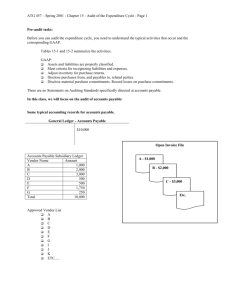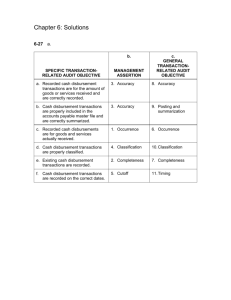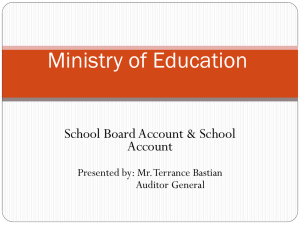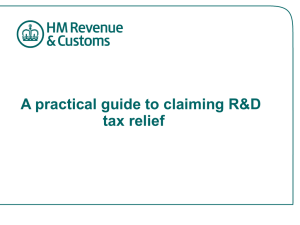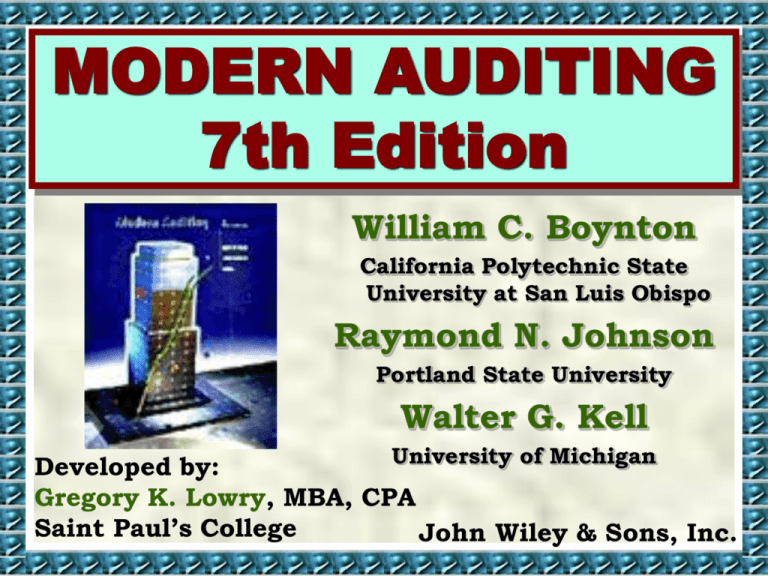
MODERN AUDITING
7th Edition
William C. Boynton
California Polytechnic State
University at San Luis Obispo
Raymond N. Johnson
Portland State University
Walter G. Kell
University of Michigan
Developed by:
Gregory K. Lowry, MBA, CPA
Saint Paul’s College
John Wiley & Sons, Inc.
CHAPTER 15
AUDITING THE EXPENDITURE CYCLE
Nature of the Expenditure Cycle
Control Activities — Purchases
Transactions
Control Activities — Cash
Disbursements Transactions
Substantive Tests of Accounts
Payable Balances
Value-Added Services
Nature of the Expenditure Cycle
The expenditure cycle consists of the
activities related to the acquisition of and
payment for goods and services. The core
expenditure cycle activities are:
1. purchasing goods and services — purchase
transactions, and
2. making payments — cash disbursement
transactions.
Purchases and cash disbursements have a
pervasive effect on the financial statements,
as depicted in Figure 15-1.
Purchases and Cash Disbursements
Figure 15-1
Debit
Merchandise inventory
Raw materials inventory
Purchases
Prepaid expenses
Plant assets
Other assets
Credit Debit
Credit
Accounts payable
Cash
Purchase discounts
Purchase returns
Various expenses
Purchase
Payment
Selected Specific Audit Objectives
for the Expenditure Cycle
Figure 15-2
Assertion
Category
Existence or
Occurrence
Transaction
Class or
Balance
Transaction
Balance
Completeness
Transaction
Balance
Rights and
Obligations
Transaction
Balance
Specific
Audit
Objectives
Recorded purchases represent goods, services, and
productive assets received during the period.
Recorded cash disbursement transactions were made
during the period to suppliers and creditors.
Recorded accounts payable represent the amounts the
entity owes at the balance sheet date.
All purchases and cash disbursements made during
the period were recorded.
Accounts payable include all amounts owed to
suppliers of goods and services at the balance sheet
date.
The entity is liable for the payables resulting from the
recorded purchase transactions.
Accounts payable are obligations of the entity at the
balance sheet date.
Assertion
Category
Valuation or
Allocation
Transaction
Class or
Balance
Transaction
Balance
Presentation
and Disclosure
Transaction
Balance
Specific
Audit
Objectives
All purchase transactions and cash disbursements are
valued using GAAP and correctly journalized,
summarized, and posted.
Accounts payable are stated at the correct amount
owed.
Related expense balances are in conformity with
GAAP.
The details of purchases and cash disbursements
support their presentation in the financial statements
including their classification and related disclosures.
Accounts payable and related expenses are properly
identified and classified in the financial statements.
Adequate disclosures have been made pertaining to
commitments, contingent liabilities, and collateralized
and related party payables.
Nature of the Expenditure Cycle
Understanding the Client’s
Business and Industry
Before designing an expenditures
audit program, the auditor must
consider the client’s business, the
external market forces driving the
business sector, and how these
forces impact the entity’s
expenditure cycle.
Nature of the Expenditure Cycle
Materiality
The expenditure cycle is a core process for
many industries and given the amount and
volume of transactions in this cycle the risk of
material misstatement is high. Figure 15-1
illustrates the fact that the transactions in this
cycle affect more financial statement accounts
than other cycles.
The allocation of materiality to accounts
affected by transactions in this cycle will vary
according to the considerations explained in
Chapter 8. The importance of the expenditure
cycle varies by the type of business.
Nature of the Expenditure Cycle
Inherent Risk
In assessing inherent risk for expenditure cycle
assertions, the auditor should consider pervasive factors
that may affect assertions throughout financial
statements as well as factors pertaining only to specific
assertions in the expenditure cycle. Pervasive factors
that might motivate management to misstate
expenditure cycle assertions include:
1. Pressures to understate expenses in order to report
achieving announced profitability targets or industry
norms, which were not achieved in reality owing to
factors such as global, national, or regional economic
conditions that affect operating costs, the impact of
technological developments on the entity’s
productivity, or poor management.
Nature of the Expenditure Cycle
2. Pressures to understate payables in order to report
a higher level of working capital when the entity is
experiencing liquidity problems or going-concern
doubts.
Both of these factors lead to a greater risk of
understatement than overstatement of expenditures and
payables.
The auditor should also consider the industry-related
factors of the availability and price volatility of the raw
materials and products needed by the entity to remain in
business.
Nature of the Expenditure Cycle
Analytical Procedures Risk
Analytical tests are effective in identifying
expenditure cycle accounts that are misstated.
Analytical procedures risk is the element of
detection risk that analytical procedures will
fail to detect material errors. Analytical
procedures are extremely cost effective.
Analytical procedures that focus only on
purchases and accounts payable provide the
most reliable information. If a company is
growing, it is common to expect purchases,
inventory, and accounts payable to grow at
consistent rates.
Analytical Procedures Commonly Used
to Audit the Expenditure Cycle
Figure 15-3
Ratio
Formula
Audit
Significance
Accounts
Payable Turn
Days
Average Accounts Payable ÷
Purchases x 365
Prior experience in accounts
payable turn days combined with
knowledge of current purchases
can be useful in estimating
current payables. A shortening of
the period may indicate
completeness problems.
Cost of Goods
Sold to Accounts
Payable
Cost of Goods Sold ÷ Accounts
Payable
Unless the company has changed
its payment policy, these amounts
should change by approximately
the same percentage from year to
year.
Payables as a
Percentage of
Total Assets
Accounts Payable ÷ Total
Assets
Common-sized balances in
accounts payable are useful in
comparing with industry data. A
significant decline in this ratio
may indicate completeness
problems.
Quick Ratio
Current Monetary Assets ÷
Current Monetary Liabilities
A significant increase in the
quick ratio compared to prior
year’s experience may indicate a
completeness problem. However,
this ratio may also be influenced
by changes in asset accounts.
Nature of the Expenditure Cycle
Consideration of Internal Control
Components
The auditor’s understanding of internal
control components is obtained by reviewing
prior experience with the client, when
applicable, and by inquiring of management
and other entity personnel, observing
activities and conditions, and inspecting
documents, records, manuals, and so forth.
The understanding should be documented in
the form of completed questionnaires,
flowcharts, or narrative memoranda.
Nature of the Expenditure Cycle
Control Environment
Numerous opportunities for employee fraud in
processing purchase and cash disbursements
transactions, and for fraudulent financial reporting
by management of expenditure cycle account
balances, make the control environment factor of
integrity and ethical values extremely important in
the expenditure cycle.
Management’s commitment to competence should be
reflected in the hiring, assignment, and training of
personnel involved in processing purchase and cash
disbursement transactions, maintaining custody of
purchased assets, and reporting on expenditure
cycle activities.
Nature of the Expenditure Cycle
The client’s organizational structure and
management’s assignment of authority and
responsibility over expenditure cycle activities should
be clearly communicated and provide for clear lines of
authority, responsibility, and reporting relationships.
When understanding how management is held
accountable for resources, it is helpful to determine:
1. The reports used by management to evaluate the
entity’s performance review.
2. How often and how quickly management reports are
reviewed.
3. The decisions that are based on the reports.
4. The entity’s policies for following up on issues
raised by key reports.
Nature of the Expenditure Cycle
Management Risk Assessment
Management risk assessments related to expenditure
cycle activities include consideration of such matters as:
1. The entity’s ability to meet cash flow requirements for
purchase transactions.
2. Loss contingencies associated with purchase
commitments.
3. The continued availability of important supplies and
the stability of important suppliers.
4. The effect of cost increases on the entity.
5. Attention to the risk of duplicate payments by the
entity.
6. Attention to the risk of employee fraud by the entity.
Nature of the Expenditure Cycle
Information and Communication
(Accounting System)
An understanding of the accounting system
requires knowledge of the methods of data
processing and key documents and records
used in processing expenditure cycle
transactions. It is important to understand
the flow of transactions through the
accounting system from initiating the
transaction to its recording in the general
ledger and eventual summarization in the
financial statements.
Nature of the Expenditure Cycle
Key information the auditor should understand
includes:
1. How purchases, payments, and returns are
initiated.
2. How purchase transactions are accounted for as
goods and services are received or goods are
returned.
3. What accounting records, documents, accounts,
and computer files are involved in accounting for
the various stages of each purchase cycle
transaction?
4. The process by which an entity initiates payment
for goods and services.
Nature of the Expenditure Cycle
Monitoring
Several types of ongoing and periodic
monitoring activities in this
component may provide management
with information concerning the
effectiveness of the other internal
control components in reducing the
risk of misstatements related to
expenditure cycle transactions and
balances.
Nature of the Expenditure Cycle
Monitoring activities about which the auditor
should obtain knowledge, when applicable,
include:
1. ongoing feedback from the entity’s suppliers
concerning any payment problems or future
delivery problems,
2. communications from external auditors
regarding reportable conditions or material
weakness in relevant internal controls found
in prior audits, and
3. periodic assessments by internal auditors of
control policies and procedures related to the
expenditure cycle.
Nature of the Expenditure Cycle
Initial Assessments of Control Risk
The auditor’s procedures to obtain an understanding
of the 4 internal control components just discussed
extend to the design of policies and procedures and
whether they have been placed in operation, but not
to determining the effectiveness of such controls.
Thus, based on the information from the
understanding only, the auditor’s initial assessment
of control risk must be at the maximum.
The auditor may perform some tests of controls
concurrently with the procedures to obtain the
required understanding. In such cases, limited
assurance may be obtained about the effectiveness
of those controls.
Control Activities —
Purchase Transactions
Virtually every company that requires an audit
has a computerized accounting system. There
are 2 types of computer controls:
1. General controls, which relate to the
computer environment and have a
pervasive effect on computer applications.
2. Application controls, which relate to the
individual computerized accounting
applications, such as the expenditure cycle.
Control Activities —
Purchase Transactions
Common Documents and Records
The following documents and records are found in
most accounting systems:
1. Purchase requisition. Written request for goods or
services by an authorized individual or department
to the purchasing department.
2. Purchase order. Written offer from the purchasing
department to a vendor or supplier to purchase
goods or services specified in the order.
3. Receiving report. Report prepared on the receipt of
goods showing the kinds and quantities of goods
received from vendors.
Control Activities —
Purchase Transactions
4. Vendor invoice. The bill from the vendor stating
the items shipped or services rendered, the amount
due, the payment terms, and the date billed.
5. Voucher. An internal form indicating the vendor,
the amount due, and payment date for purchases
received. It is used to authorize recording and
paying a liability. Many purchase systems require a
complete voucher packet before approving
payment. The voucher packet usually contains a
copy of the appropriate purchase requisition,
purchase order, receiving report, vendor invoice,
and voucher — all the documentation supporting
the purchase transaction.
Control Activities —
Purchase Transactions
6. Exception reports. Reports with information
about transactions identified for further
investigation by computer application controls.
7. Voucher summary. Report of total vouchers
processed in a batch or during a day.
8. Voucher register. Formal accounting record of
recorded liabilities approved for payment.
9. Approved vendor master file. Computer file
containing pertinent information on vendors and
suppliers that have been approved to purchase
services from and make payments to.
10. Open purchase order file. Computer file of
purchase orders submitted to vendors for which
the goods or services have not been received.
Control Activities —
Purchase Transactions
11. Receiving file. Computer file with
receiving information on quantities of
inventory received from vendors.
12. Purchase transactions file. Computer
file containing data for approved
vouchers for purchases that have
been received. Used to print the
voucher register and update the
accounts payable, inventory, and
general ledger files.
Control Activities —
Purchase Transactions
13. Accounts payable master file.
Computer file containing data on
approved unpaid vouchers. The file
may be organized by vendor. It
should sum to the balance in the
accounts payable control account.
14. Suspense files. Computer file that
hold transactions that have not been
processed because they have been
rejected by computer application
controls.
Control Activities —
Purchase Transactions
Functions
The processing of purchase transactions
involves the following purchasing functions:
1. Initiating purchases. The request by an
entity for a transaction with another
entity, including:
a. Placing vendors on an authorized
vendor list.
b. Requisitioning goods and services.
c. Preparing purchase orders.
Control Activities —
Purchase Transactions
2. Receipt of goods and services. The physical
receipt or shipment of a product or service,
including:
a. Receiving the goods.
b. Storing goods received for inventory.
c. Returning goods to a vendor.
3. Recording liabilities. The formal recognition by
an entity of a legal obligation, including:
a. Preparing the payment voucher and recording
the liability.
b. Accountability for recorded transactions.
Control Activities —
Purchase Transactions
Obtaining an Understanding and Assessing
Control Risk
The auditor should obtain an understanding of the
purchase cycle that is sufficient to plan the audit.
If the auditor plans to assess control risk as low for
an assertion, it is particularly important that he or
she obtain an understanding of control procedures
for that assertion.
Tests of controls provide the means for determining
the effectiveness of such controls. The extent of
the auditor’s consideration of factors related to
assessing control risk for any given assertion
depends on audit strategy.
Control Activities —
Purchase Transactions
Inherent risk for purchase transactions is
often considered to be at the maximum or
high, because:
1. the purchase cycle has a pervasive effect
on the financial statements and
2. the susceptibility of assets to
misappropriation.
The auditor should also consider the results
of analytical procedures to determine the
planned assessed levels of control risk and
tests of details risk.
Control Activities —
Purchase Transactions
If the auditor plans to assess control risk as
low, he or she will usually have to:
1. test the effectiveness of general controls,
2. use computer-assisted audit techniques
(CAATs) to evaluate the effectiveness of
programmed controls, and
3. test the effectiveness of procedures to
follow up on exceptions identified by
programmed controls.
Control Activities —
Cash Disbursement Transactions
Common Documents and Records
Important documents and records used in processing
cash disbursement transactions include the following:
1. Check. Formal order to a bank to pay the payee the
amount indicated on demand.
2. Check summary. Report of total checks issued in a
batch or during a day.
3. Cash disbursement transaction file. Information on
payments by check to vendors and others. Used for
posting to the accounts payable and general ledger
master files.
4. Cash disbursement journal or check register. Formal
accounting record of checks issued to vendors and
others.
Control Activities —
Cash Disbursement Transactions
Functions
The cash disbursement function is the
process by which a company provides
consideration for the receipt of goods
and services. The cash disbursement
function normally involves
simultaneously paying the liability and
recording the cash disbursement.
Example control procedures are
summarized in Figure 15-7.
Control Risk Components —
Cash Disbursement Transactions
Figure 15-7
Function
Cash
Disbursement
Potential
Misstatement
A check may
not be
recorded.
A check may
not be
recorded
promptly.
Computer Controls
Manual Controls
in Italics
Account Balance Audit Objectives
EO2
C2
RO2
VA2
PD2
Computer accounts
for prenumbered
check series.
Computer compares
the total on the
check summary with
the total vouchers
submitted for
payment.
Access to blank
checks and signature
plates is controlled.
D
Computer prints
report of checks due
but not yet paid.
Run-to-run totals
compare beginning
cash, less cash
disbursements, with
ending cash balance
as well as beginning
accounts payable
less disbursements
with ending accounts
payable.
D
P
P
D
Function
Cash
Disbursement
Potential
Misstatement
Checks may
be issued for
unauthorized
purchases.
Computer Controls
Manual Controls
in Italics
Account Balance Audit Objectives
EO2
C2
RO2
VA2
PD2
Computer compares
check information
with purchase order
and receiving
information or other
authorization.
Computer performs a
limit test on large
disbursements and
checks must be
manually signed
D
A voucher
may be paid
twice.
Computer has a field
that identifies that a
voucher has been
paid and the voucher
number cannot be
reused.
D
A check may
be issued for
the wrong
amount.
Computer
comparison of check
amount with related
voucher amount.
D
P
D
Function
Cash
Disbursement
Potential
Misstatement
Computer Controls
Manual Controls
in Italics
A check may
be altered
after being
signed.
Manual control
requires that check
signers mail checks.
Independent bank
reconciliation.
Errors may be
made in
recording the
check.
Computer
comparison of
information on check
summary with
related voucher
information.
Independent bank
reconciliation.
Cash
disbursements
may be made
for
unauthorized
purchases or
they may be
made in the
wrong amount.
Management
Control
An appropriate level
of management
monitors cash daily,
including the amount
of checks written
daily, the
reasonableness of the
amounts, and the
amount of debits to
accounts payable
daily.
Account Balance Audit Objectives
EO2
C2
RO2
VA2
PD2
P
D
D
D
D
D
D
D
D
D
D
Control Activities —
Cash Disbursement Transactions
Obtaining an Understanding and Assessing
Control Risk
The auditor should obtain an understanding of
internal controls that is sufficient to plan the audit.
If the auditor plans to a low assessed level of control
risk for an assertion, he or she will probably need to
understand specific control procedures related to
that assertion.
Tests of controls provide the means for assessing
the effectiveness of internal controls. The nature
and extent of tests of controls will vary inversely
with the auditor’s planned assessed level of control
risk.
Substantive Tests of
Accounts Payable Balances
Determining Detection Risk for Tests of
Details
Accounts payable are affected by both
purchase transactions that increase the
balance and by cash disbursement
transactions that decrease the balance.
Thus, tests of details risk for accounts
payable assertions is affected by inherent
risk, analytical procedures risk, and control
risk factors related to both of these
transaction classes.
Correlation of Risk Components —
Accounts Payable Assertions
Figure 15-9
Existence
or
Occurrence
Completeness
Rights
and
Obligations
Valuation
or
Allocation
Presentation
and
Disclosure
Audit Risk
Low
Low
Low
Low
Low
Inherent Risk
High
High
Moderate
High
High
Moderate
High
Moderate
Moderate
High
Control Risk
— Purchase
Transactions
Low
High
Moderate
High
Moderate
Control Risk
— Cash
Disbursement
Transactions
Moderate
Low
Low
Low
Low
Combined
Control Risk
Moderate
High
Moderate
High
Moderate
Acceptable
Tests of
Details Risk
Moderate
Very Low
Moderate
Moderate
Very Low
Risk
Component
Analytical
Procedures
Risk
Substantive Tests of
Accounts Payable Balances
Designing Substantive Tests
The general framework for developing
audit programs for substantive tests
that was explained in Chapter 11 and
illustrated in Chapter 14 for accounts
receivable can also be used in
designing substantive tests for
accounts payable. Multiple tests are
keyed to each account balance audit
objective.
Substantive Tests of
Accounts Payable Balances
Accounts Payable Confirmations
Unlike the confirmation of accounts
receivable, there is no presumption made
about the confirmation of accounts payable.
This procedure is optional because:
1. confirmation offers no assurance that
unrecorded payables will be discovered
and
2. external evidence in the form of invoices
and monthly vendor statements should be
available to substantiate the balances.
Value-Added Services
Generally accepted auditing standards do
not require that the auditor perform
value-added services. Nevertheless, when
auditors complete an audit they are
usually very knowledgeable about the
client’s business and business practices,
the results of its operations and cash
flows, as well as the entity’s internal
controls. Management and the board of
directors normally want to take full
advantage of the auditor’s knowledge.
CHAPTER 15
AUDITING THE EXPENDITURE CYCLE
Copyright
Copyright 2001 John Wiley & Sons, Inc. All rights
reserved. Reproduction or translation of this work
beyond that permitted in Section 117 of the 1976
United States Copyright Act without the express
written permission of the copyright owner is
unlawful. Request for further information should
be addressed to the Permissions Department, John
Wiley & Sons, Inc. The purchaser may make backup
copies for his/her own use only and not for
distribution or resale. The Publisher assumes no
responsibility for errors, omissions, or damages,
caused by the use of these programs or from the
use of the information contained herein.

